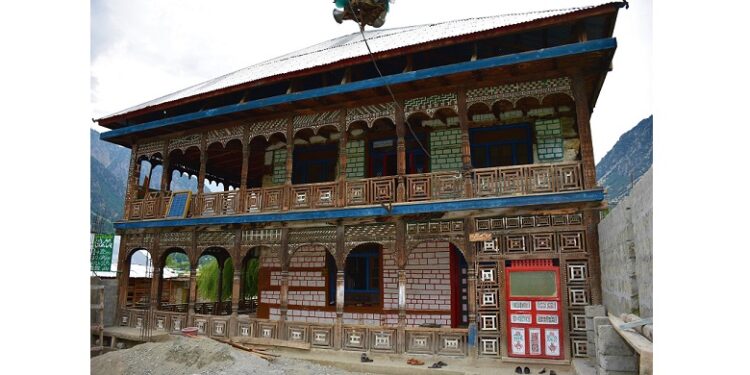
Amongst various artisans in the Gabar area in Tangir valley, Feroz Khan is the most celebrated and accomplished woodcarver and mason.
Zulfiqar Ali Kalhoro
Fururi and Dabas villages in Tangir valley are especially noted for their exquisite wooden mosques. I visited both villages first in 2000. I went back to them later in 2001, 2009 and 2019 respectively. During my frequent visits to Tangir valley in the Diamer district, I met many celebrated woodcarvers (Darus Gars) and masons who built impressive mosques and engraved wooden pillars and doors – for both secular and religious architecture in the Tangir valley. During each of my visits, I had several interviews with woodcarvers and masons to document the intangible heritage of the valley.
Amongst various artisans in the Gabar area in Tangir valley, Feroz Khan is the most celebrated and accomplished woodcarver and mason. There are a few painted wooden mosques in Tangir valley which are known to have been built by Feroz Khan. The most impressive wooden mosques are located in Fururi and Dabas villages. Feroz Khan is himself a resident of Fururi village.
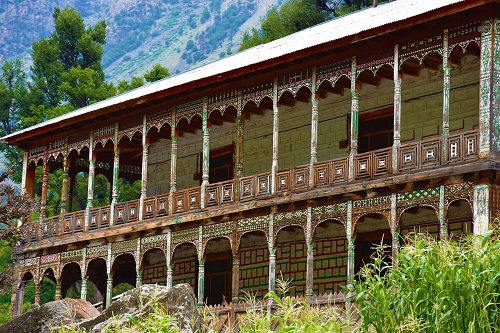
Sir Aurel Stein (d. 1943) was the first European to visit Tangir and Darel. He recorded the history and heritage of both the valleys in his book Innermost Asia Vol. 1. Like other places, he also mentioned about Fururi mosque. He took a photo of the Fururi mosque and used it in his book. The Fururi mosque resembled the Khamikot mosque which is the most ancient mosque in Tangir valley. The old mosque of Fururi was demolished in 1982. According to Feroz Khan, the old mosque was a single storey with a covered verandah. Pillars of both covered verandah and the main prayer hall were ornately carved. The doorway of the mosque was also fabulously carved representing floral and geometric designs.
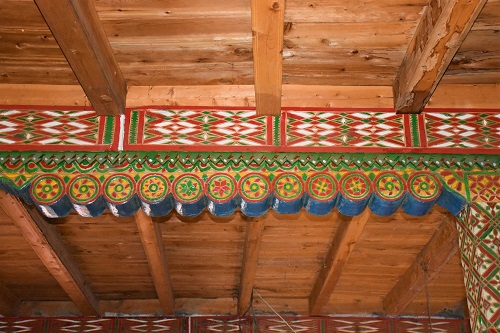
According to Feroz Khan, construction of the new mosque of Fururi, now called Medina Mosque Fururi, started in 1983 and was completed in 1986. Three other masons, all from Fururi village, helped Feroz Khan in the construction of the mosque. His eldest brother Hyder Khan and two other helpers included Abdul Baqi and Zarmad Khan. Feroz Khan did all the work of woodcarvings. The mosque is a double-story structure with two arcades on the south and west of the prayer hall. Both the western and southern verandah runs along the entire length of the prayer hall. The facade of the verandah shows a series of fluted columns on which rest multi-cusped arched openings. It is decorated with fretted panels at the parapet. The verandah on both the lower and upper stories is partially enclosed by a railing which represents the same geometric design probably influenced by the earliest wooden mosques in Tangir valley.
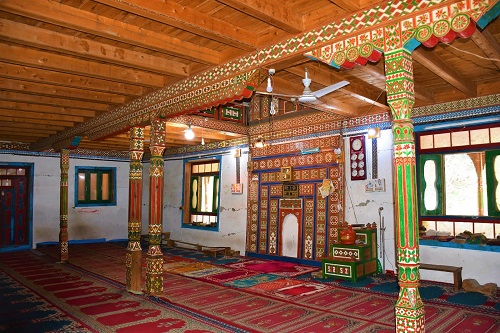
The main door to the covered verandah is contained within a rectangular frame made of similar fretted panels which are seen in railings. The doorway from the southern verandah opens to the main prayer hall. Four pillars, which rise from a common square base, support the roof of the prayer hall of the lower story. These pillars are decorated with floral and geometric designs. The pillars have bracket capitals with seven volutes on each side. This is entirely an innovation by Feroz Khan. One can see at least two to three voluted capitals in old mosques at Gayal, Phuguch, Birokot, and Manikyala Bala in Darel valley and Khamikot in Tangir valley. A majority of mosques that were built after the 1980s adopted the same architectural model with a decrease in the number of pillars and an increase in volutes. This was probably done to support the load of a roof with a single long beam and numerous volutes. The majority of the mosques built in Tangir valley adopted this model.
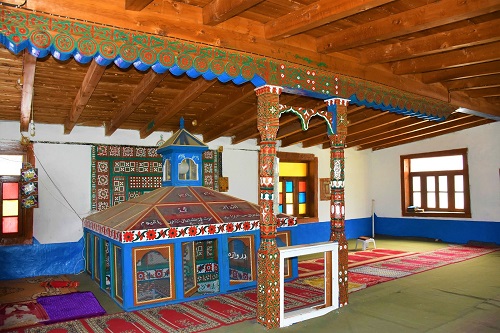
Voluted capitals on the northern and southern sides of the main prayer hall are decorated with geometric designs whereas those on the western and eastern enclose floral motifs. Likewise, wooden beams are decorated with floral and geometric designs as well. The most decorative and impressive feature of the mosque is the wooden mihrab. The wooden mihrab represents both geometric and floral designs. All these wood carvings are tastefully painted. The roof of the upper storey rests on two octagonal pillars. Interestingly, Feroz Khan has increased the number of volutes from seven to twelve on each of the bracket capital. These volutes have varied floral decorations. The same number of volutes were also added on bracket capitals in the Jami mosque of Dabas village which was also built by Feroz Khan. This mosque is located on the left bank of Tangir River. The construction of Jami mosque of Dabas village started on 1 April 1991 and was completed on 5 January 1995. Two other masons, Nader Khan and Satbar Khan, both from Jaglot, were his students and helped Feroz Khan in the construction of the mosque. It is also a double-story on the same model as Fururi mosque. But there are a few differences, which include an additional arcade on the northern side and the number of pillars has been increased in the Jami mosque Dabas. There is a long verandah on the upper story, running on the south, west, and north of the prayer hall.
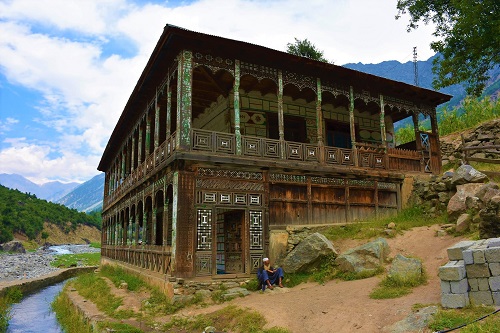
The decoration in the Jami mosque of Dabas is also varied as compared to Furui mosque. The main doorway of the mosque is ascetically carved, which opens to the main prayer hall. The roof of the mosque rests on highly carved and painted pillars. The same number of pillars also support the roof of the upper story of the mosque. Two pillars are located in the center of the mosque with floral and geometric designs. Both pillars have twelve volutes on each side. Two other pillars in the north and south equally have three voluted capitals. The same construction model is adopted on the second story. The elongated mihrab which touches the roof of the second story is highly carved. The decoration scheme of the mihrab is the most impressive in the entire Tangir valley. The frame of the mihrab depicts a minaret motif.
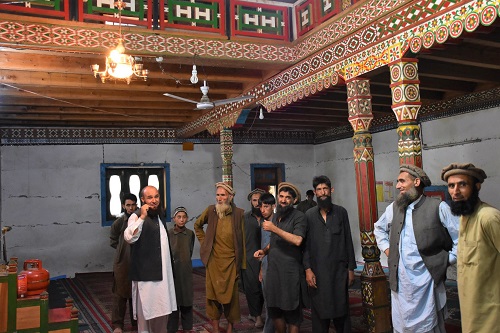
This is the most outstanding motif of its type, which I have not seen in any other recently built mosque in Tangir and Darel. One can also see another interesting religious symbol, which is probably a carving of a mosque on a pillar in the Jami mosque in Dabas village. It depicts a dome surmounted with a minaret/finial flanked by a pair of moon and star. I have not seen a religious motif of this type in any other mosque in the Diamer district in Gilgit-Baltistan and neighboring Indus-Kohistan in Khyber Pakhtunkhwa. However, I have seen wood carvings of Islamic religious symbols in other valleys in Khyber Pakhtunkhwa. The most prominent Islamic religious representations include the Holy Kaabah and the mosque of Thal and Lamuti in Dir-Kohistan in the Upper Dir district, which I will discuss in detail when I write on the wooden mosques of this area.
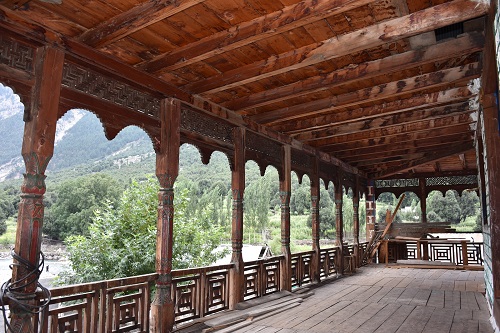
Apart from the minaret motif, the most noticeable carvings in the Jami mosque of Dabas village are the vases. Every motif in the mosque reflects the skill and mastery of Feroz Khan. He learned from his predecessors, who introduced to him many old schemes of motifs that were prevalent in both the religious and secular architecture of the Tangir valley. Apart from that, he also introduced new designs, noticeably religious symbols and motifs that were previously not used in any of the mosques in the Gabar area of Tangir valley. He has transferred his knowledge to his students, who carry his legacy and use the same scheme of motifs in some of the recently built wooden mosques of Koranga Bala, Koranga Pain and other villages in the Tangir valley.
_______________
 Dr. Zulfqar Ali Kalhoro, an anthropologist, has authored 12 books including ‘Symbols in Stone: The Rock Art of Sindh’, ‘Perspectives on the art and architecture of Sindh’, ‘Memorial Stones: Tharparkar’ and ‘Archaeology, Religion and Art in Sindh’. He may be contacted at: zulfi04@hotmail.com
Dr. Zulfqar Ali Kalhoro, an anthropologist, has authored 12 books including ‘Symbols in Stone: The Rock Art of Sindh’, ‘Perspectives on the art and architecture of Sindh’, ‘Memorial Stones: Tharparkar’ and ‘Archaeology, Religion and Art in Sindh’. He may be contacted at: zulfi04@hotmail.com
Courtesy: The Friday Times Lahore